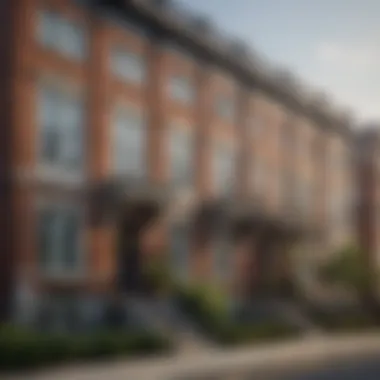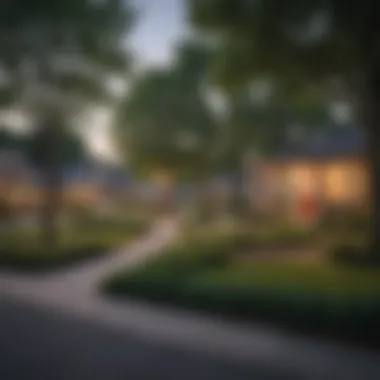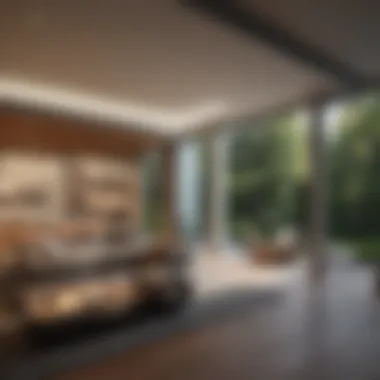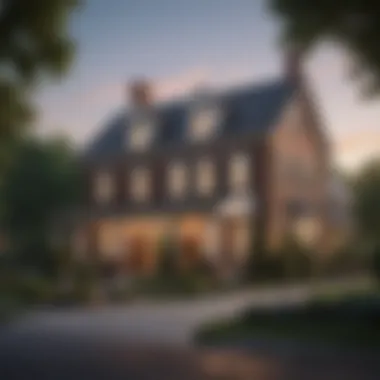Exploring Homes in Washington, DC: A Comprehensive Overview


Intro
In the heart of one of the most powerful cities in the world lies a rich tapestry of homes that reflect various historical eras and cultural influences. From stately brownstones to modern condominiums, Washington, DC offers a plethora of architectural styles, each with its own narrative. This article is designed to provide an in-depth overview of the diverse landscape of homes in Washington, DC, highlighting key aspects such as design inspiration, neighborhood characteristics, and evolving market trends.
The capital's residential scene captures the essence of its vibrant neighborhoods. It showcases homes that not only serve as living spaces but also function as vital components of a larger socio-economic framework. Understanding this dynamic is essential for potential homeowners, real estate investors, and even those with a casual interest in the architecture of the nation’s capital.
As we explore the homes of Washington, DC, we will delve into architectural styles that define the city, the historical significance of various neighborhoods, and the interplay between aesthetics and functionality. Additionally, we will examine market trends influenced by both local and national economic factors, offering insights to those navigating the complex world of real estate.
This guide aims to be a valuable resource, shedding light on what makes residential life in Washington, DC unique. We invite readers to join us on this journey as we uncover the architectural diversity and market dynamics that shape homes in this historic city.
Intro to Washington, Homes
Understanding the homes in Washington, DC is crucial for anyone who is interested in real estate or urban living. The city’s housing market reflects a unique blend of history, culture, and architectural diversity. This overview allows potential homeowners, real estate investors, and architectural enthusiasts to grasp what shapes the residential landscape of the capital.
In Washington, DC, homes are not merely structures; they are reflections of the city’s rich past and its evolving identity. The importance of this topic is magnified when considering the different influences that have shaped residential spaces through the years. From the historical landmarks that tell a story of America’s foundation to contemporary designs that embrace sustainability, each home has its narrative.
There are specific elements to consider when delving into this topic. The areas where these homes are located often dictate their value and the lifestyle they offer. With neighborhoods like Capitol Hill, Georgetown, and Adams Morgan, one can observe the stark contrasts and the appeal each area provides. Additionally, understanding the local real estate trends, market dynamics, and demographic shifts plays a significant role in making informed decisions.
By exploring the homes in Washington, DC, one gains insight into how historical context and cultural significance blend to create vibrant residential communities. This analysis serves as a guide for exploring not only housing options but also the quality of life they offer.
Historical Context
Washington, DC has a complex and rich historical background that deeply influences its residential architecture. From its establishment in 1790, the city was designed with specific grid patterns and monumental buildings in mind, reflecting the neoclassical style. Many early homes were built in the Federal style, characterized by symmetry and classic detailing.
As the city grew, different architectural movements took root. The Victorian era introduced elaborate designs, embodied in the charming row houses of Dupont Circle. Even as progress marched on, older styles did not fade away but rather fused with new ones, resulting in a patchwork of architectural styles that define the city today.
This rich tapestry is not only an aesthetic asset but also a reminder of the social changes throughout the years. Each era's homes can tell a story of the people who lived in them, from politicians to artists, reflecting the diverse fabric of America's history.
"The homes of Washington, DC are more than just places to live; they are historical artifacts that narrate the city's past."
Cultural Significance
The cultural impact of Washington, DC's homes cannot be overstated. They serve as a backdrop to significant national events and personal stories alike. The city acts as a meeting point for various cultures and influences, further emphasized by its neighborhoods. Each locale presents a unique character shaped by its residents’ diverse backgrounds.
For example, Georgetown has a history intertwined with pre-revolutionary America, showcasing colonial architecture and cobblestone streets that attract tourists and residents alike. Adams Morgan, in contrast, is known for its lively, eclectic vibe, blend of ethnic restaurants, and vibrant nightlife.
The homes in these communities reflect not just architectural trends but also the values and lifestyles of their inhabitants. This blend of culture enhances the appeal of Washington, DC homes, making them coveted properties that appreciate in value while maintaining their unique charm. Understanding these cultural aspects provides insight into how one can engage with the community and embrace life in this remarkable city.
Architectural Styles
The architectural styles present in Washington, DC, provide a fascinating lens through which to explore the city's residential landscape. Understanding these styles is essential, as they reflect not only the aesthetic preferences of their eras but also the social and economic conditions that influenced their design. Different architectural styles affect the character of neighborhoods, shape the experiences of residents, and hold distinct historical significance. For potential homeowners, recognizing these styles can aid in making informed choices that align with personal preferences and lifestyle needs.
Colonial Revival
The Colonial Revival style, popular in the late 19th and early 20th centuries, is a leading architectural theme in Washington, DC. With its roots in the early American colonial architecture, this style evokes a sense of heritage and nostalgia. Key features include symmetrical facades, elaborate doorways, and classic columns. Homes in this style often harmonize well with the city’s history, appealing to those who appreciate tradition and craft.
Moreover, the Colonial Revival celebrates attention to detail. For instance, multi-paned windows and brick or clapboard siding are common. The style often incorporates modern conveniences while maintaining a vintage appearance. This allows homeowners to enjoy contemporary living in a context that honors the past.
Many Colonial Revival homes are found in neighborhoods like Capitol Hill, where they contribute to the area's distinguished atmosphere. For buyers seeking a connection to history, these homes present a compelling option.
Brick Row Houses


Brick row houses are emblematic of urban living in Washington, DC. These structures line the streets in many neighborhoods, including Georgetown and Adams Morgan. The uniformity and continuity of brick row houses create a cohesive streetscape, which enhances community feeling.
The design features a narrow, elongated layout, often with three or more stories. The exteriors are predominantly made of red or brown brick, contributing to the warmth and character of the cityscape. Notably, many of these homes include decorative elements like wrought iron railings or stone details, which provide individuality while maintaining a collective aesthetic.
Advantages of brick row houses include their spacious interiors and the potential for outdoor spaces, like small gardens or patios. For urban dwellers seeking a sense of history and community, these homes are often a preferred choice.
Modern Designs
In contrast to the historical styles, modern designs in Washington, DC reflect contemporary tastes and values. This architectural approach emphasizes clean lines, open spaces, and minimalistic aesthetics. Often made with concrete, glass, and steel, modern homes stand out amidst the historical narrative that characterizes much of the city.
The modern style prioritizes functionality, making it appealing for those who value innovation and sustainability. Features may include large windows that enhance natural lighting, energy-efficient materials, and smart home technologies. As urban lifestyles evolve, modern designs resonate with a demographic seeking convenience, efficiency, and a connection to the present.
Notably, areas like The Wharf are becoming increasingly recognized for their modern residences. These homes not only contribute to a fresh urban atmosphere but also accommodate diverse lifestyle needs, from young professionals to growing families.
The diversity in architectural styles across Washington, DC, not only enriches the city’s landscape but also provides potential residents with options that reflect their individual tastes and lifestyles.
Neighborhood Profiles
Understanding the distinct neighborhoods of Washington, DC is crucial for anyone interested in the housing market or lifestyle considerations in the area. Each neighborhood offers a mix of historical significance, cultural elements, and unique amenities that attract different types of residents. This section provides an overview of some of the key neighborhoods, highlighting their characteristics and the specific benefits of living in each one. By examining these profiles, prospective homeowners can make informed decisions about where to invest or find their perfect home.
Capitol Hill
Capitol Hill is one of the most recognized neighborhoods in Washington, DC. It is known for its historic homes and proximity to the United States Capitol. The architecture features stunning federal-style buildings, brick row houses, and Victorian homes. Living on Capitol Hill provides a vibrant community feel, with access to parks, farmers’ markets, and a strong neighborhood association.
Key Features:
- Heritage: The neighborhood is rich in history, often associated with politics and governance.
- Access: Residents enjoy convenient access to public transport, making commuting easier.
- Community Events: Frequent community gatherings foster a strong sense of belonging.
Georgetown
Georgetown stands out with its rich blend of elite history and modern flair. It is often recognized as one of the oldest neighborhoods in DC, with charming cobblestone streets and upscale boutiques. The waterfront location adds to its charm, offering scenic views and recreational activities.
Why Choose Georgetown?
- Cultural Significance: The neighborhood is home to many historical landmarks and cultural institutions.
- Dining Scene: Renowned for its diverse culinary options, Georgetown attracts food enthusiasts.
- Shopping and Entertainment: Numerous high-end shops and entertainment venues enhance the lifestyle experience.
Adams Morgan
Adams Morgan is known for its eclectic vibe and cultural diversity. It features a variety of architectural styles, from historic brownstones to contemporary lofts. This neighborhood is a hotspot for nightlife, with an array of bars and live music venues.
Attractions of Adams Morgan:
- Cultural Events: The area hosts various festivals, showcasing its rich diversity.
- Vibrant Nightlife: Numerous clubs and bars make it a lively place for younger residents.
- Art and Creativity: A thriving arts scene, with many galleries and artists’ studios.
The Wharf
The Wharf is part of the most recent development projects in Washington, DC. It is a waterfront community that emphasizes modern living while still paying homage to its maritime roots. With stunning views, parks, and eateries along the waterfront, it has become a sought-after location for newcomers.
Noteworthy Elements:
- Lifestyle Amenities: The Wharf offers a blend of shopping, dining, and entertainment options.
- Recreational Areas: Ample green spaces and waterfront access for outdoor activities.
- Community Engagement: Regular events foster a lively community atmosphere.
Each neighborhood in Washington, DC offers a unique lifestyle that can significantly impact daily living and long-term investment in property. Recognizing these distinct qualities helps guide potential homeowners in their search for a residence that matches their values and aesthetics.


Real Estate Market Analysis
Understanding the real estate market is crucial for anyone interested in homes in Washington, DC. This analysis provides a snapshot of the current home-buying landscape, assessing various factors such as prices, demand, and market dynamics. By examining the real estate market, stakeholders can make informed decisions whether they are buyers, investors, or renters.
Current Trends
The current trends in the Washington, DC housing market reveal significant insights. The demand for homes has shown resilience despite broader economic uncertainties. Interest rates remain relatively low, which encourages buyers to enter the market. Popular areas like Capitol Hill and Georgetown have seen rising prices due to their desirable amenities and historic charm.
Key trends include:
- An increase in the number of remote workers seeking more space.
- A shift towards suburban living as buyers prioritize yard space and home offices.
- Continued investment in urban revitalization projects, enhancing neighborhood appeal.
These elements contribute to a dynamic and competitive market, making it essential for potential buyers to stay updated with ongoing developments.
Historical Price Comparisons
When analyzing the historical pricing trends in Washington, DC, one can observe fluctuations that align with broader economic cycles. Over the past decade, home prices have generally increased, reflecting a robust demand coupled with limited inventory.
Price comparisons reveal:
- An approximate 3% annual increase in home values over the last five years.
- A shift from luxury condos to more affordable single-family homes in recent years.
- The impact of economic disruptions, like the COVID-19 pandemic, which temporarily influenced pricing strategies and buyer preferences.
These historical perspectives help prospective homeowners understand the market's resilience and its potential for future growth.
Future Projections
Looking ahead, various factors will shape the future of the Washington, DC housing market. Experts predict that the market will continue to evolve, influenced by both local and national economic conditions. Key projections include:
- Anticipated stabilization in home prices as inventory balances with demand.
- Ongoing interest from first-time homebuyers, reflecting demographic changes and economic recovery.
- Potential regulatory changes impacting lending practices and housing development.
Understanding these future projections is crucial for anyone navigating the market. Being informed allows buyers to make strategic choices, whether they plan to purchase a new home or invest in rental properties.
"The real estate market in Washington, DC shows both challenges and opportunities, making thorough analysis indispensable for potential investors and homeowners alike."
Amenities and Lifestyle Considerations
Amenities and lifestyle considerations are critical when assessing homes. They reflect how a community enhances the living experience for its residents. In Washington, DC, this includes various elements such as public transport, parks, and the culinary scene. Each of these factors plays a significant role in attracting potential homeowners and impacting property values.
Accessibility to Public Transport
Transportation is vital for convenience and connectivity in urban living. Washington, DC boasts an extensive public transport system, including the Metro and numerous bus lines. The Metro system is especially noteworthy, providing access to vital areas like downtown, the National Mall, and suburbs. Homebuyers often prioritize neighborhoods that offer proximity to Metro stations. The ability to commute easily can save time significantly. Moreover, reliable public transit options can enhance the overall quality of life, making it easier to explore the cultural and social offerings in the city.
- Types of public transport available:
- Metro rail services
- Bus services
- Ride-sharing options
Proximity to Parks and Recreation
Living near parks and recreational areas can greatly enhance a neighborhood’s appeal. Washington, DC is rich in green spaces, from the expansive National Mall to various local parks. These areas provide more than just natural beauty; they offer activities for residents, fostering a sense of community and well-being. Access to parks allows families and individuals to engage in outdoor activities, promoting a healthier lifestyle.
Key considerations include:
- Children’s play areas
- Walking and biking paths
- Community sports facilities


A significant aspect of DC parks is their design, encouraging community interaction. Various events, like outdoor concerts and farmers' markets, help bonds between neighbors.
Culinary Scene
The culinary scene is another critical lifestyle consideration. Washington, DC offers a rich variety of dining options that cater to diverse tastes. From fine dining restaurants to food trucks, the choices are vast. The city is known for its vibrant neighborhoods with unique culinary offerings. Areas like Georgetown and Adams Morgan showcase eclectic restaurants that draw both locals and tourists.
Local marketplaces feature a selection of fresh produce and gourmet foods, enhancing the food culture. This landscape attracts individuals passionate about food, adding depth to the community. Residents benefit from:
- Diverse cuisine options
- Opportunities to support local businesses
- Culinary events and festivals
"A city’s culinary scene is a reflection of its culture and community. Washington, DC is no exception, showcasing exceptional diversity in its food offerings."
Sustainability Trends in Home Design
Sustainability in home design has gained prominence as an essential consideration for homeowners and builders alike. The residential landscape in Washington, DC is no exception, as a growing number of properties integrate sustainable practices. Focusing on sustainability not only benefits the environment but also enhances living quality and reduces long-term costs. Homebuyers today prioritize energy efficiency and eco-friendly materials, making sustainability a pivotal factor in real estate decisions.
Green Building Practices
Green building practices involve the use of sustainable materials, efficient waste management, and the overall goal of minimizing environmental impact. In Washington, DC, many new homes and renovations adopt a holistic approach characterized by several key elements:
- Sustainable Materials: Builders frequently choose materials that are renewable, recycled, or locally sourced.
- Water Efficiency: Home designs often incorporate fixtures and systems to reduce water consumption, contributing to lower utility bills.
- Indoor Air Quality: Implementing non-toxic paint and materials helps improve the air quality within homes.
- Innovative Designs: Architects are creating spaces that encourage natural light, reducing the need for artificial lighting during the day.
These practices align with the broader movement towards environmental responsibility, making homes more appealing to a conscientious buyer. The popularity of green building certifications, such as LEED, further showcases the emphasis on sustainable construction.
Energy Efficiency Initiatives
Energy efficiency initiatives play a significant role in the sustainability trends seen in Washington, DC's housing market. Homeowners increasingly seek strategies to optimize energy use in their residences, leading to substantial cost savings and environmental benefits. Key components of energy efficiency initiatives include:
- Advanced Insulation: Proper insulation prevents heat loss during winter and keeps homes cooler in summer, minimizing the need for heating and cooling systems.
- Energy-Star Appliances: Households are investing in appliances rated for energy efficiency, which significantly lowers energy consumption and costs.
- Smart Home Technology: Automated systems that control heating, lighting, and security contribute to reduced energy waste.
- Solar Energy Use: Many homes are integrating solar panels to harness renewable energy, further decreasing reliance on non-renewable sources.
The trend towards energy efficiency not only benefits the homeowner but also has a profound impact on reducing the carbon footprint of the city.
In summary, sustainability trends in home design reflect a growing awareness of environmental impact and a commitment to innovative solutions. Washington, DC is at the forefront of this movement, showcasing how residential properties can balance modern living with ecological responsibility.
Ending
When examining the housing landscape in Washington, DC, it becomes clear that this topic is significant for various reasons. The diverse architectural styles, unique neighborhood characteristics, and current market trends do not just define the physical structures but also shape the community and lifestyle of its residents. Understanding these elements is crucial for anyone interested in the real estate market, as they play a key role in determining property values and desirability.
The findings discussed throughout this article shed light on the intricacies of Washington, DC's housing. From historical insights that give context to the real estate present, to insights on modern amenities that enhance living experiences, it is evident that the dynamics of this city's homes continue to evolve.
"Washington, DC stands as a vibrant example of how architecture and urban planning intertwine with culture and history."
In summary, when potential homeowners consider buying in Washington, DC, they must weigh not only the aesthetics and location of homes but also the surrounding amenities and future market trends. This understanding allows them to make informed decisions, ensuring that they choose spaces that meet their needs now and in the future.
Summary of Findings
The exploration of homes in Washington, DC reveals several key findings:
- Architectural Diversity: The city boasts a mix of styles, including Colonial Revival and modern designs, making it appealing to a wide audience.
- Neighborhood Appeal: Areas like Capitol Hill and Georgetown offer rich historical and cultural contexts, enhancing quality of living.
- Market Trends: Current trends suggest a balancing act between maintaining historic integrity and embracing new developments to enhance sustainability.
This overview highlights the crucial interplay between a city's architectural landscape and its real estate dynamics.
Implications for Future Homeowners
With the insights gained, prospective homeowners should consider the following:
- Investment in History: Homes in historically significant neighborhoods may offer stable or appreciating property values due to their unique character.
- Sustainability Focus: Homes that incorporate green building practices will likely be in demand as more buyers emphasize environmental considerations.
- Urban Accessibility: Future homeowners should prioritize accessibility to public transport and local amenities, which enhance daily living.
Overall, understanding these factors allows future homeowners to not just invest in property, but also in a lifestyle that resonates with their values and preferences.







